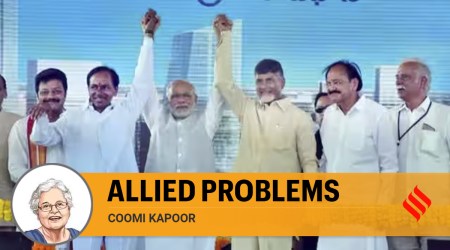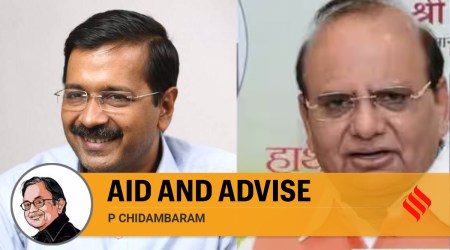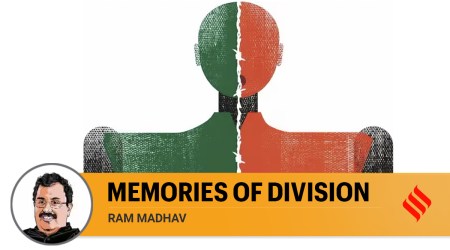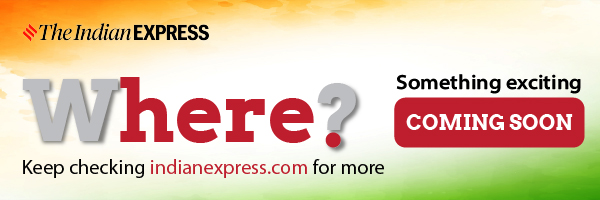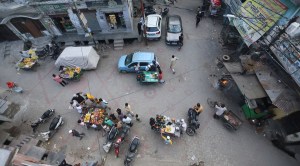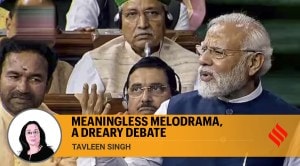Why the minimum age for Indian MPs must be brought down to 21
It is time that there is a higher infusion of young blood into India’s parliamentary system. When the minimum age to discharge the extensive duties of an IAS/IPS officer is 21, why can’t the same apply to legislators?
 It is time that there is a higher infusion of young blood into India’s parliamentary system. (PTI)
It is time that there is a higher infusion of young blood into India’s parliamentary system. (PTI) Written by Jayant Chaudhary
On May 18, 1949, the Constituent Assembly of India, tasked with creating Independent India’s Constitution, got into a heated debate. The debate was on the issue of the insertion of an Article that set guidelines, such as the minimum age for a prospective parliamentarian in India. The motion aimed to set 25 years as the minimum age to enter the Lok Sabha and 35 years to enter the Rajya Sabha. Durgabai Deshmukh, one of the tallest leaders of India’s freedom struggle who worked relentlessly for women’s emancipation, moved an amendment to this motion. She wanted to reduce the minimum age to enter Rajya Sabha from 35 to 30, and quoted, “It was held for some time that greater age confers greater wisdom on men and women, but in the new conditions we find our boys and girls more precocious and more alive to their sense of responsibilities. Wisdom does not depend on age. The educational curriculum is now so broad-based that it will educate them very well in respect of their civic rights and duties. I, therefore, think we should give a chance to these younger people to be trained in the affairs of state.”
Speaking in favour of this amendment, socialist leader H V Kamath mentioned William Pitt who entered the UK parliament at 21 and became the prime minister of the country at 24. Kamath held that the minimum age should be uniformly reduced to 21 for entering either House of Parliament. Durgabai’s amendment found support from other eminent figures such as Shibban Lal Saxena (who was arrested for organising a hartal in Kanpur to protest the Jallianwala Bagh massacre) and Tajamul Hussain (barrister and two-time Rajya Sabha MP). The amendment was adopted and today it remains in our constitution as Article 84 and Article 173. These Articles prescribe 25 and 30 years as the lower limit for entry into the lower and upper houses respectively at both the Centre and in state assemblies.
The “boys and girls” of India that Durgabai alluded to while moving her amendment live in a highly globalised era today. Young men and women are cognisant of their rights and responsibilities and are vocal about all political issues. International movements like “Fridays for Future” that advance climate change dialogue globally were started by young activists like Greta Thunberg at age 15. Undoubtedly, young people are recognising their own agency in determining a more sustainable and equitable growth-oriented lifestyle and pattern which is rooted in the recognition of diversity and rights-based governance. All this augurs well for us, but the moot question is: Do our youth really have a seat at the high table?
It is well recognised that young people face obstacles to the enjoyment of their rights by virtue of their age, limiting their potential. Pursuant to a United Nations Human Rights Council resolution, the Office of the High Commissioner for Human Rights published a report on youth and human rights in 2018. The report documented the challenges for young people in accessing civil, political, social, economic and cultural rights. The report noted that globally, youth are under-represented in political institutions, with less than 2 per cent of parliamentarians aged under 30. Moreover, the age of candidacy for national parliaments, and especially for higher office, is not always aligned with the minimum voting age.
In the Indian context, let’s look at our university campuses and student politics which are supposed to foster free debate, open the minds of the youth to critical thinking and develop well-rounded perspectives. In 1979, Laxmi Shankar Ojha got elected to the Allahabad University Students Union (AUSU) at the age of 52. Ironically, his daughter graduated from the university in the same year. From those times, India’s student politics has come a long way. The Lyngdoh Committee recommendations were adopted in 2012 that set upper age limits to contest in student union elections in India. A Hindustan Times study of office bearers of student unions in India’s top universities revealed that the average age of these leaders stood at a promising 22.5 years in 2019. This figure is proof that a good policy aimed at bringing young voices of the university to the forefront worked to empower them and gave us these stunning results.
At the Panchayat level as well with reduced age criterion, we have witnessed a great churn across most states with a larger number of younger men and women of 21 years and above, finding representation at the level of village pradhan, member of zilla parishad, block pramukh, etc. The case of the Indian Parliament, however, is much bleaker when we consider the average age of its legislators. India had its first Lok Sabha and Rajya Sabha parliament sessions on May 13, 1952. Since then, according to a study by PRS Legislative Research, the share of MPs in the age bracket of 25-40 declined from 26 per cent in the first Lok Sabha to a mere 12 per cent in the ongoing 17th Lok Sabha. This figure comes at a time when the entire world is discussing India’s tremendous advantage in its “demographic dividend”. India is a “young country” where 65 per cent of India’s population is below 35 years of age. A whopping 600 million people in India are aged between 18 to 35 today. India’s median age stands at an exciting 28.2 years. The minimum age to enter the Rajya Sabha (30 years) is more than the country’s median age. This needs introspection and immediate legislative correction.
The 132nd Report on Specific Aspects of Election Process and Their Reform (Presented to the Rajya Sabha on August 4, 2023) by the Department-Related Standing Committee on Personnel, Public Grievances, Law and Justice, gives welcome recommendations in this regard. The report suggests lowering the minimum age to contest elections anywhere in India to 18 years, at par with India’s minimum age to vote. The report goes on to state in Section 3.3 that “most European countries stipulate that candidates for national general elections must be at least 18 years old. However, some countries, including Bulgaria, the Czech Republic, Estonia, Ireland, Latvia, Poland, and Slovakia, have higher age requirements, mandating that candidates be at least 21 years old.” The report notes the relevance of young members of Parliament as the spokespersons for India’s burgeoning youth population. They tend to raise topical issues that are of contemporary relevance such as the advent of artificial intelligence, the flight of large numbers of India’s young citizens to foreign countries, and the unemployment crisis in India.
Surprisingly, the Election Commission does not favour reducing the age requirement for membership of Parliament and State Legislatures and still maintains that 18-year-olds do not possess the necessary experience and maturity for these responsibilities. Over 2,000 years ago, Plato held that political competence and maturity come only with age. It was similar reasoning that led to 35 years as the initial minimum age limit for entering the Rajya Sabha at the Constituent Assembly. This is an outdated logic. As all major democracies around the world have striven to address this issue and lowered their minimum age requirements for entering their parliament houses, the biggest democracy in the world lags behind.
On December 9, 2022, the author of this article introduced a Private Member’s Bill in the Rajya Sabha, the Constitution (Amendment) Bill, 2022. It seeks to amend Article 84 and Article 173 of the Constitution to reduce the minimum age of prospective legislators to contest elections to 21 years from the current 25 years at the Centre and state. The legal age of marriage for men in India is 21 years and the Prohibition of Child Marriage (Amendment) Bill, 2021 aims to bring women’s minimum marriageable age at par with men at 21. I believe that 21 years could be the appropriate middle ground between the recommendations of the parliamentary committee to lower the minimum age to contest elections to 18 and the Election Commission of India which favours the status quo.
Studies from around the world have demonstrated that the representation of certain groups in parliament ensures increased visibility of their issues. This is the reasoning for the long-standing demand for a women’s reservation quota in the assemblies that will ensure more gendered discussions. Similarly, the representation of India’s minorities and SC/ST groups has ignited discussions about their communities. It is time that there is a higher infusion of young blood into India’s parliamentary system. When the minimum age to discharge the extensive duties of an IAS/IPS officer is 21, why can’t the same apply to legislators? Today, 21-year-olds are making decisions for our nation, serving as urban councillors or village heads, manning the borders and gallantly protecting the nation, winning accolades for us in sports, providing jobs as employers in unicorns and startups, taking decisions for their family as married adults or even as parents. Most importantly at 21 years, our youth is voting, but strangely is barred from participating wholesomely in our democracy as candidates.
My Private Bill is in continuation of efforts to build a political consensus on the issue of the age of candidacy. On February 12, 2019, Rashtriya Lok Dal organised a Youth Rights Seminar at the Constitution Club of India and passed a resolution to reduce the age to 21 years at the meet which was attended by many prominent leaders of the I-N-D-I-A Alliance. I hope bipartisan support will help bring about the required constitutional changes to enable younger faces to get into Parliament in 2024.
The writer is Member of Parliament, Rajya Sabha. He was assisted by LAMP intern, Bibin Thomas
EXPRESS OPINION
Must Read
More Explained
Aug 13: Latest News
- 01
- 02
- 03
- 04
- 05


